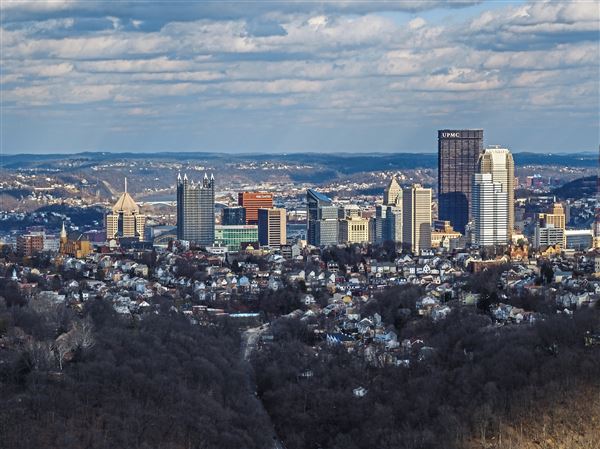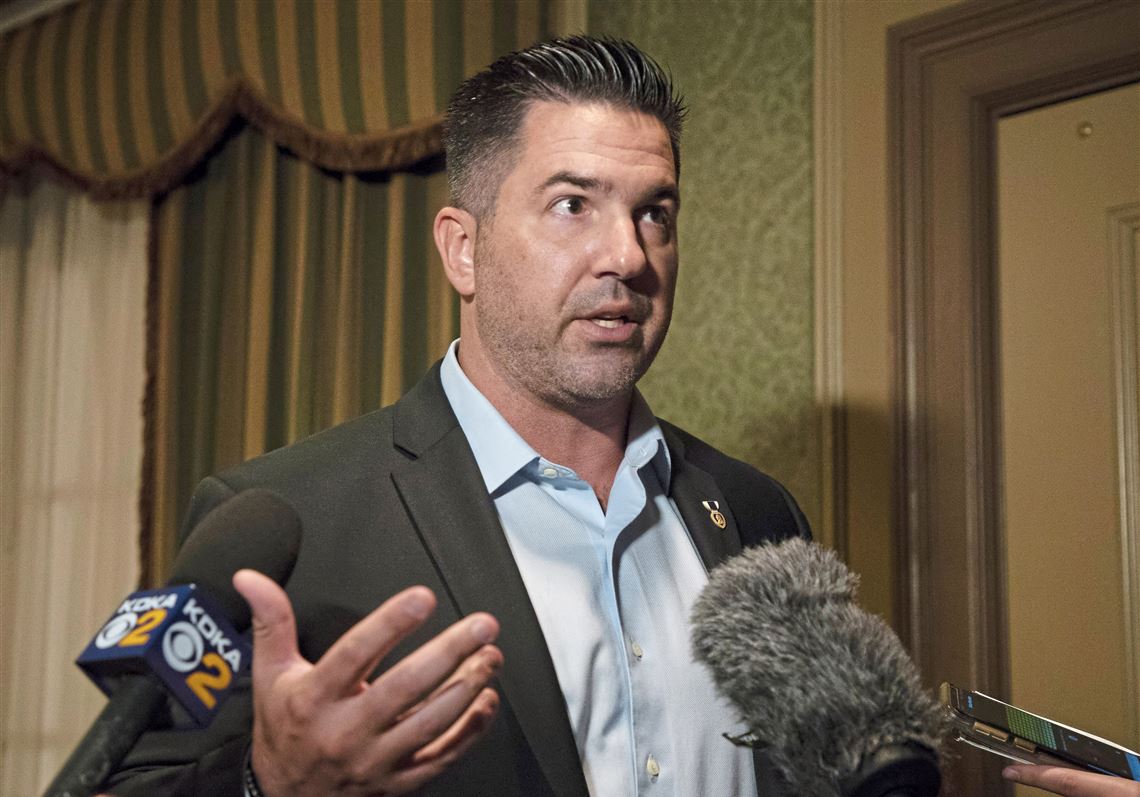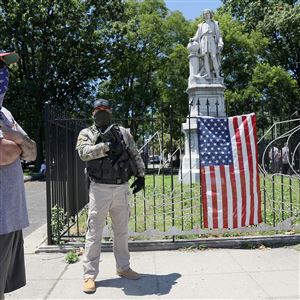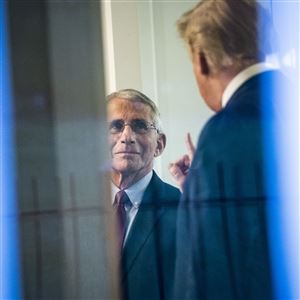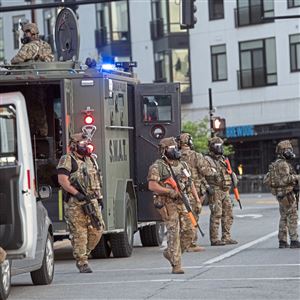On the day President Donald Trump took to Mount Rushmore to declare that the nation is “witnessing a merciless campaign to wipe out our history” and tear down historical monuments of revered figures, his endorsed candidate for Pennsylvania’s 17th Congressional district — Sean Parnell — issued a similar warning.
But Mr. Parnell, the Republican nominee hoping to unseat incumbent Democrat Conor Lamb in November, took it a step further, as academics and political analysts said. In a video posted to his Twitter account on the evening of the president’s speech, the candidate claimed that the U.S. is a “nation at war whether we’d like to admit it or not” — and said the “enemies” are “here on our soil.”
Those enemies are “trying to burn our country to the ground,” Mr. Parnell says in the video, before showing images — one by one — of burning and toppled statues of U.S. historical figures — monuments that have been reexamined, and in some instances, torn down, amid the national conversation and widespread civic participation in recent months surrounding systemic racism.
Rattling off the names of George Washington, Thomas Jefferson, Ulysses S. Grant and Abraham Lincoln and deeming their monuments a target of the “mob” propped up and endorsed by the Democratic Party, Mr. Parnell says, “The goal is to erase our history, destroy America from within, tear it down brick-by-brick.”
“They hate America. They hate our history. And they hate you,” Mr. Parnell says.
The video — accompanied by a link to donate to his campaign — has since been viewed about 300,000 times on Twitter, and was shared by the president’s son, Donald Trump Jr., who wrote on Facebook that it was an example of “how every Republican should take on the mob.”
In interviews this past week, local political analysts and academics, including one who studies public monuments and another who examines grassroots organizing and its historical implications, deemed the candidate’s rhetoric intense in its voracity, a near-copy of the president’s recent playbook and a vapid and insincere interpretation of a more complex series of movements.
Kirk Savage, a professor of history of art and architecture at the University of Pittsburgh who studies the identity and memory of public monuments, said he’s amazed that the tearing down of statues has triggered this rhetoric, and that over the past several weeks, there have only been a “few high profile take-downs” of monuments. Thousands and thousands of statues remain standing, Mr. Savage said.
“This is a tiny, tiny fraction of them, and much of the [protesting] … most of it has been quite peaceful,” Mr. Savage said, adding that “there are more statues being removed by civic processes than there are by mob or vigilante groups.”
The professor conceded that it’s not easy to make a “hard and fast distinction” between Confederates and other kinds of white supremacists, and that some have tried to draw the line at Confederate statues only “because you can say they weren’t really Americans” and were allegiant to the Confederate States of America — formed to protect the institution of slavery, he noted.
Mr. Savage said there’s a deep history of white supremacy in the U.S., and that to grapple with it, it’ll also take reexamining the monuments of known enslavers and of monuments celebrating the dispossession of Native land.
“Legitimately, there is the argument that if you’re going to take on the issue of white supremacy, if we’re going to reckon with our history, we’ve got to reckon with these folks, too, and their monuments,” Mr. Savage said.
That doesn’t mean all of George Washington’s statues should be taken down, Mr. Savage said, but that there should be an honest discussion about his role as a slave owner and in the upholding of the institution of slavery. Many of America’s founding fathers were “deeply invested … in slavery,” Mr. Savage said.
Mr. Parnell’s campaign did not respond to requests for an interview, or to a written set of specific questions about the video and the larger issues of race and justice in the U.S.
The video
In the video, Mr. Parnell, a veteran of the War in Afghanistan during which he commanded an infantry platoon in combat as an Army Ranger, says he’s going to fight for America at home like he did abroad. He pins the current moment as a “time for choosing” — a choice between fighting for the “American way of life” or “[kneeling] to the mob that wants to destroy our country,” as an image flashes on the screen of protesters hitting a police car.
Asserting that the Democrats “endorse mob violence against Americans and the destruction of our country” and the defunding of the police, Mr. Parnell asks viewers to recall a time when Democrats in Washington denounced Antifa or “the mob.”
“If you don’t denounce the mob, you endorse the mob,” Mr. Parnell says, as the video transitions to an image of Mr. Lamb, his opponent, posing with protesters — who carried signs with messages about defunding the police and “[making] racism wrong again.”
“More than 130,000 Americans have died, millions of Americans have been laid off, and he’s talking about statues and a second civil war,” Abby Nassif-Murphy, Mr. Lamb’s campaign manager, said in a statement.
Christopher Borick, director of Muhlenberg College’s Institute of Public Opinion, said Mr. Parnell is aligning with Mr. Trump’s rhetorical playbook on cultural issues, attempting to put a face to the Democratic opposition in the meantime.
Republicans see advantages in this strategy, Mr. Borick said, because the American public is generally opposed to civic unrest when it becomes violent or turns into a riot. At the same time, Americans are generally supportive of the broader issues and concerns being raised in the protests, Mr. Borick said.
In Mr. Trump’s Mount Rushmore speech the day before the Fourth of July, he said “angry mobs are trying to tear down statues of our Founders, deface our most sacred memorials, and unleash a wave of violent crime in our cities.”
In his video, Mr. Parnell links the images of statues and protests to one of his main campaign themes: that the Democratic Party is no longer “your grandfather’s Democratic Party.”
Featured in the video are pictures of Congresswomen Alexandria Ocasio-Cortez, Ilhan Omar, Ayanna Pressley and Rashida Tlaib — frequent ideological targets of Republicans who claim that their progressive views are seeping into the mainstream of the party.
Resonating with some
The rhetoric about Democrats being extremists and socialists resonates with some voters in the district who might not believe the party’s members are socialist by definition, but think Democrats are more likely to vote for tax increases, said Lara Putnam, professor and chair of the Department of History at the University of Pittsburgh who studies the electoral landscape in Western Pennsylvania.
For other voters, they may hear the argument through a cultural frame which says Democrats are going to take away “hard-working Americans’ money and give it to undeserving people,” Ms. Putnam said, making it clear that it’s not her framing, but what the political right is trying to tap into.The question is whether the GOP has maximized the political capital they can get from this kind of framing with white voters, Ms. Putnam said.
Ms. Putnam said there certainly are people in the district who voted Democratic two decades ago, are deeply disaffected by the party and most likely did not vote for Mr. Lamb — and for whom culture issues might resonate with their sense of aggrievement. But Ms. Putnam said she is doubtful those voters will make the difference for Mr. Parnell, and that his rhetoric might turn many voters away. She noted that in the 17th district, there have been protests headed by clergy members, community leaders and high school students.
“School kids in North Allegheny and the well-attended Black Lives Matters protests speak to the difficulty Sean Parnell is going to have convincing folks in that district he seeks to represent that these protests are an assault on American democracy,” Ms. Putnam said. “It’s local school kids who are saying, ‘here we are standing for what we believe in.’”
Mr. Parnell ends the video by framing the election in November as a battle between freedom and tyranny, “good versus evil” and “the American way of life versus the end of our country.”
“This is the time to fight,” Mr. Parnell says. “America is at war and we need wartime leaders. I fought for America before and I’ll do it again.”
Julian Routh: jrouth@post-gazette.com, 412-263-1952, Twitter @julianrouth.
First Published: July 12, 2020, 10:00 a.m.
